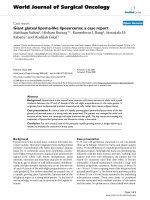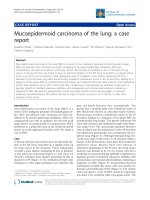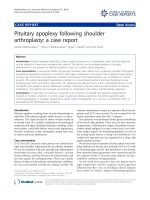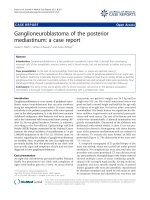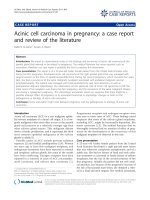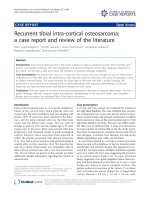Báo cáo y học: " Pituitary apoplexy following shoulder arthroplasty: a case report" ppt
Bạn đang xem bản rút gọn của tài liệu. Xem và tải ngay bản đầy đủ của tài liệu tại đây (349.85 KB, 4 trang )
CASE REP O R T Open Access
Pituitary apoplexy following shoulder
arthroplasty: a case report
Savitha Madhusudhan
1*
, Thayur R Madhusudhan
2
, Roger S Haslett
3
and Amit Sinha
2
Abstract
Introduction: Pituitary apoplexy following a major surgical procedure is a catastrophic event and the diagnosis
can be delayed in a previously asymptomatic patient. The decision on thromboprophylaxis in shoulder
replacements in the absence of definite guidelines, rests on a careful clinical judgment.
Case presentation: A previously healthy 62-year-old Caucasian male patient who underwent shoulder arthroplasty
developed hyponatremia resistant to correction with saline replacement. The patient had a positive family history
of deep vein thrombosis and pulmonary embolism and heparin thromboprophylaxis was considered on clinical
grounds. The patient developed hyponatremia resistant to conventional treatment and later developed ocular
localizing signs with oculomotor nerve palsy. The diagnosis was delayed due to other confounding factors in the
immediate post-operative period. Subsequent workup confirmed a pituitary adenoma with features of pituitary
insufficiency. The patient was managed successfully on conservative lines with a multidisciplinary approach.
Conclusions: A high index of suspicion is required in the presence of isolated post-operative hyponatremia
resistant to medical correction. A central cause, in particular pituitary adenoma, should be suspected early.
Thromboprophylaxis in shoulder replacements needs careful consideration as it may be a contributory factor in
precipitating this life-threatening cond ition.
Introduction
Pituitary apoplexy resulting from an acute hemorrhage or
infarction of the pituitary gland usually occurs in a macro-
adenoma. The rapid increase in tumor volume results in
an abrupt onset of a variable combination of neurological
symptoms and signs including headache, vomiting, ocular
nerve palsies, visual field defects, visual acuity impairment,
Horner’s syndrome, stroke, meningism, stupor and coma
as well as endocrine dysfunction.
Case presentation
A 62-year-old C aucasian male patient was admitted for
right total shoulder replacement for an arthritic shoulder.
He was on treatment with non-steroidal anti-inflammatory
medication for pain relief, a thiazide diuretic, calcium
channel blocker and beta blockers for hypertension, and
low dose aspir in for cardioprotection. There was a family
history of deep vein thrombosis and pulmonary embolism.
He was a non-smoker and did not consume alcohol. His
systemic examination, routine pre-operative blood investi-
gations and ECG were normal. He was accepted for the
elective procedure under the ASA 2 category.
The operation was performed under general anesthesia
in the beach chair position. There were no intra-operative
complications. Following the surgery, the patient was pre-
scribed opioid analgesics for pain control and a low mole-
cular weight heparin for t hromboprophylaxis, in view of
the strong family history of deep vein th rombosis. For
comfort the operated arm wa s supported in a sling, with
gentle assisted exercises.
On the second post-operative day the patient was mobi-
lizing well but was drowsy and confused; GCS was 15 with
no localizi ng signs and his vital parameters were normal.
Post-operative blood parameters were normal except for
low sodium (Table 1). Normal saline infusion was pre-
scribed for correction of hyponatremia.
On the third post-operative day, the patient had a
high temper ature and the surgical wound appeared
inflamed but there was no discharge. Blood sa mples
were sterile on culture. Heparin thromboprophylaxis
* Correspondence:
1
St. Pauls Eye Unit, Royal Liverpool University Hospital, Liverpool L7 8XP, UK
Full list of author information is available at the end of the article
Madhusudhan et al. Journal of Medical Case Reports 2011, 5:284
/>JOURNAL OF MEDICAL
CASE REPORTS
© 2011 Madhusudhan et al; licensee B ioMed Central Ltd. This is an Open Access article dis tributed under the terms of the Creative
Commons Attribution License ( which permits unrestricted use, distribution, a nd
reproduction in any medium, provided the original work is proper ly cited.
was discont inued and mechanical thromboprophylactic
measures were instituted.
Over the next 48 hours, the patient complained of
increasing bilateral frontal headaches with onset of bino-
cular diplopia on the fifth post-operative day which was
closely followed by increased urinary output, worsening
confusion and dr owsiness. The patient w as transferred
to the acute medical unit for further evaluation and
management.
In the acute medical unit, the patient continued to be
drowsy but oriented. His vital obser vations were nor mal.
The GCS was 13 with no neck stiffness or photophobia.
His speech was normal with good swallowin g reflexes.
There were no motor or sensory deficits in any of the four
limbs. His gait was normal, Rhomberg’s sign was negative
and there were no other localizing signs. His bladder and
bowel functions were normal.
Ophthalmologic evaluation at this stage recorded visual
acuities of 6/5 in the right eye and 6/9 in the left eye. The
pupils were equal and reacting normally to light with brisk
direct and consensual reflexes. There was no anisocoria.
Fundus examination revealed normal optic discs with
well-defined margins and normal retinal vasculature. A
complete ptosis of the right upper eyelid and restriction of
adduction, elevation and depression in the right eye sug-
gested a pupil-sparing right complete third nerve palsy. A
computed tomography (CT) brain scan (Figure 1) wa s
requested to rule out any compressive pathology causing
this nerve palsy, which revealed a low attenuation signal in
the pituitary fossa suggestive of either a thrombosed
aneurysm or a bleed into the pituitary gland. Pituitary
function tests and an endocrinologist’ sopinionwere
requested. Pituitary profile and synacthen stimulation tests
suggested pan-hypopituitarism (Table 2, Table 3). It is
important to note that recent onset central adrenal insuffi-
ciency (secondary to apoplexy), often has an adequate
serum cortisol response to ACTH. He was prescribed
hydrocortisone and thyroxine replacement therapy.
In the next 24 hours, he complained of reduced vision
in his left eye; visual acuities now measured 6/5 in the
right eye and 6/12 in the left eye; color desaturation in
the temporal hemifields was noted, using a red target. A
confrontation field test suggested superior bitemporal
quandrantanopia; more accurate examination with
automated perimetry was not possible, given the
patient’s condition. His optic discs continued to be nor-
mal. Repeat blood tests were normal except f or low
sodium and low hemoglobin levels (Table 1). Thiazides
were discontinued and oral ferrous sulfate supplementa-
tion was initiated.
He was optimized medically and transferred to a ter-
tiary c enter for further evaluation. An MRI scan of his
brain further confirmed that t he pituitary stalk was
markedly deviated to the right with an enhancing area
in the pit uitary fossa, suggesting an adenoma. There was
no extension of the pituitary into the suprasellar cistern
and the chiasm was not compressed. His internal carotid
artery anatomy was normal. He was managed further on
conservative lines and discharged on hydrocortisone and
thyroxine supplements, and testoste rone replacement
therapy.
On subsequent review, visual acuities had recovered to
6/5 in both eyes; color vision was normal; diplopia had
resolved with fully restored extra-ocular movements.
There was no ptosis, indicating good recovery from the
third nerve palsy. A repeat MRI sc an of our patient’s
Table 1 Blood biochemistry values (all values in mmol/L)
Date Sodium Potassium Urea Creatinine Glucose CRP LFT
pre-op 137 4.1 7.0 84 4-8 3 U Normal
2
st
post-op day 127 4.4 4.4 94 4.9 34 U
5
th
post op day 128 5.1 6.8 126
7
th
post op day 132 5.1 8.5 118
4 weeks post op 138 3.8 5.9 114 6.3
Figure 1 Coronal CT scan showing the pituitary infarct.
Madhusudhan et al. Journal of Medical Case Reports 2011, 5:284
/>Page 2 of 4
brain at three months showed a small residual adenoma
in the right pituitary fossa with the gland displaced to
the left. He was discharged from active care o n success -
ful recovery and is being followed up on elective outpa-
tient medical, ophthalmology and shoulder clinics.
Discussion
The clinical presentation of pituitary apoplexy can be
variable. Although in retrospect our patient had some o f
the classical findings - headache, altered mental status,
oculomotor nerve palsy and visual field loss and persis-
tent hyponatremia, resistant to medical correction - in
thepresenceofconfoundingfactorsincludingtheuseof
thiazide diuretics, expected transient fluid-ele ctrolyte
imbalance f ollowing general ane sthesia and surgical
blood loss [1], and the suspicion of sepsis in the immedi-
ate post-operativ e period, the diagnosis was delayed until
the evolution of ophthalmic signs. These signs prompted
radiological imaging and a definite diagnosis. Pit uitary
apoplexy presenting as hyponatremia secondary to hor-
mone deficient adrenal insufficiency, following orthope-
dic su rgery is documented, [2] but requires a high inde x
of suspicion for investigations to be directed towards an
early diagnosis.
Cranial nerve involvement in pituitary tumor and apo-
plexy has been well described. Compression of the oculo-
motor nerve in its intra-cavernous course as the gland
swells and impinges on the cavernous sinus, commonly
gives rise to mydriasis, limitation of eye movement and
ptosis in that sequence [3]. The superficially located pupil-
lomotor fibers ar e easily prone to compres sion from
space-occupying lesions, while microvascular disease
affecting the vasa nervosum in the main nerve trunk
usually spares the pupillary fibers. Pupillary involvement
provides an important clue in differentiating medical and
surgical causes, although pupillary sparing does not always
exclude a compressive lesion. Pituitary apoplexy can cause
a sudden increase in the size of a pre-existing pituitary
tumor and tempo rary impingement on the optic chiasm
giving rise to bitemporal hemianopia and impaired vision.
Despite various medications and medical interven-
tions, head trauma and pregnancy have been described
as being causative of p ituitary apoplexy [4-6] along with
spontaneous bleeding into a pituitary neoplasm, when
associated precipitating factors are not always easily
identifiable [7]. Following major surgeries, hemodilution,
hypotension, anti-coagulation and stress have all been
implicated as risk factors. Pre-operatively our patient
was asymptomatic and there were no signs of intra-cra-
nial mass effect or pituitary dysfunction from the pitui-
tary adenoma . Therefore further investigati ons were not
carried out. With no definite identifiable factors respon-
sible for his post-operative intra-tumor bleed, we believe
hepa rin treatment might have been contributory in pre-
cipitating clinically symptomatic pituitary apoplexy.
There are other reported cases of anticoagulation ther-
apy precipitating pituitary tumor apoplexy [8].
Deep vein thrombosis and pulmonary embolism are
recognized complications of total hip and knee arthro-
plasty [9] and definite guidelines for prevention and
treatment of these complications exist for effective peri-
operative management. However no guidelines exist for
elective shoulder replacements. Several case reports and
the occurrence of deep vein thrombosis and pulmonary
embolism following shoulder replacements have been
described in the published literature [10-13]. Due to the
paucity of available evidence for thromboprophylaxis in
shoulder replac ements, the operating surgeon in many
situations has to use his clinical judgment. In our
patient, there was a strong family history of deep vein
thrombosis and pulmonary embolism and low molecular
weight heparin thromboprophylaxis was instituted. Un til
definite evidence and guidelines are available, hepa rin
therapy in shoulder replacements will need careful
consideration.
Conclusion
Pituitary apoplexy as a cause of persistent hyponatremia
resistant to medical correction is possible following
shoulder replacement surge ry. The presentation may be
atypical particularly in the presence of various confound-
ing factors in the peri-operative period. A multidisciplin-
ary team input is required, for better management and
for preventing life-threatening complications. Conserva-
tive ma nagement with hormone replacement is success-
ful in patients even with delayed presentation and
diagnosis.
Table 2 Hormonal values: 5
th
post op day and at 1 year follow-up
Date Free T4 TSH LH FSH Prolac-tin Corti-sol Free testos-terone Testos-terone ACTH SHBG
5 days post op 6 pm/L 0.36 mu 0.3 u 0.7 u 17 mu/l 30 nm/L .002 nm/L 0.1 nm/L 17 ng/L 30 nm/L
4 weeks post op 12
pm/L
1.3 mu/L 16 nm/L
Table 3 Synacthen test
5 days post op 0 mins - 321 nmol/L
65 mins - 214 nmol/L
12 weeks post op 0 mins - 452 nmol/L
65 mins - 299 nmol/L
Madhusudhan et al. Journal of Medical Case Reports 2011, 5:284
/>Page 3 of 4
Consent
Written informed consent was obtained from the patient
for publication of this case report and any accompany-
ing images. A copy of the written consent is available
for review by the Editor-in-Chief of this journal.
Author details
1
St. Pauls Eye Unit, Royal Liverpool University Hospital, Liverpool L7 8XP, UK.
2
Department of Trauma and Orthopaedics, Glan Clwyd Hospital, Rhyl LL18
5UJ, UK.
3
Department of Ophthalmology, H M Stanley Hospital, St. Asaph
LL17 0RS, UK.
Authors’ contributions
SM is the principal author and was involved in the collection of data, review
of the literature, and preparation of the manuscript. TRM was involved in the
collection of relevant literature and proof read the manuscript. RH and AS
were senior authors and were actively involved in patient care and proof
read the manuscript. All authors were actively involved in direct patient care
and have read and approved the manuscript.
Competing interests
The authors declare that they have no competing interests.
Received: 13 January 2010 Accepted: 5 July 2011 Published: 5 July 2011
References
1. Steele A, Gowrishankar M, Abrahamson S, Mazer CD, Feldman RD,
Halperin ML: Postoperative hyponatremia despite near-isotonic saline
infusion: a phenomenon of desalination. Ann Intern Med 1997, 126:20-25.
2. Thomason K, Macleod K, Eyres KS: Hyponatraemia after orthopaedic
surgery - a case of pituitary apoplexy. Ann R Coll Surg Engl 2009, 91:3-5.
3. Kim SH, Lee KC, Kim SH: Cranial nerve palsies accompanying pituitary
tumour. J Clin Neurosci 2007, 14:1158-1162.
4. Nawar RN, AbdelMannan D, Selman WR, Arafah BM: Pituitary tumor
apoplexy: a review. J Intensive Care Med 2008, 23:75-90.
5. Riedl M, Clodi M, Kotzmann H, Hainfellner JA, Schima W, Reitner A, Czech T,
Luger A: Apoplexy of a pituitary macroadenoma with reversible third,
fourth and sixth cranial nerve palsies following administration of
hypothalamic releasing hormones: MR features. Eur J Radiol 2000, 36:1-4.
6. Thurtell MJ, Besser M, Halmagyi GM: Pituitary apoplexy causing isolated
blindness after cardiac bypass surgery. Arch Ophthalmol 2008,
126:576-578.
7. Biousse V, Newman NJ, Oyesiku NM: Precipitating factors in pituitary
apoplexy. J Neurol Neurosurg Psychiatry 2001, 71:542-545.
8. Tan TM, Caputo C, Mehta A, Hatfield EC, Martin NM, Meeran K: Pituitary
macroadenomas: are combination antiplatelet and anticoagulant
therapy contraindicated? A case report. J Med Case Reports 2007, 1:74.
9. Venous thrombolism, reducing the risk of venous thromboembolism
(deep vein thrombosis and pulmonary embolism) in patients
undergoing surgery. [ />10. Sperling JW, Cofield RH: Pulmonary embolism following shoulder
arthroplasty. J Bone Joint Surg Am 2002, 84-A(11):1939-1941.
11. Lyman S, Sherman S, Carter TI, Bach PB, Mandl LA, Marx RG: Prevalence
and risk factors for symptomatic thromboembolic events after shoulder
arthroplasty. Clin Orthop Relat Res 2006, 448 :152-156.
12. Saleem A, Markel DC: Fatal pulmonary embolus after shoulder
arthroplasty. J Arthroplasty 2001, 16:400-403.
13. Madhusudhan TR, Shetty SK, Madhusudhan S, Sinha A: Fatal pulmonary
embolism following shoulder arthroplasty - a case report. J Med Case
Reports 2009, 3:8708.
doi:10.1186/1752-1947-5-284
Cite this article as: Madhusudhan et al.: Pituitary apoplexy following
shoulder arthroplasty: a case report. Journal of Medical Case Reports 2011
5:284.
Submit your next manuscript to BioMed Central
and take full advantage of:
• Convenient online submission
• Thorough peer review
• No space constraints or color figure charges
• Immediate publication on acceptance
• Inclusion in PubMed, CAS, Scopus and Google Scholar
• Research which is freely available for redistribution
Submit your manuscript at
www.biomedcentral.com/submit
Madhusudhan et al. Journal of Medical Case Reports 2011, 5:284
/>Page 4 of 4

